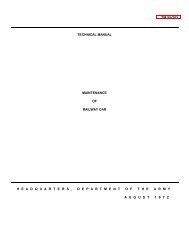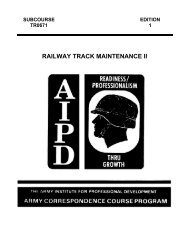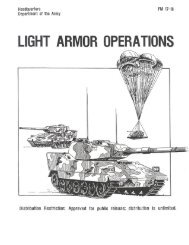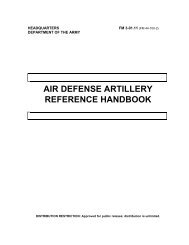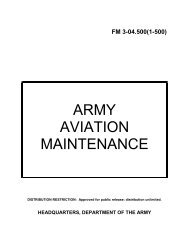fm 44-100 us army air and missile defense operations
fm 44-100 us army air and missile defense operations
fm 44-100 us army air and missile defense operations
Create successful ePaper yourself
Turn your PDF publications into a flip-book with our unique Google optimized e-Paper software.
FM <strong>44</strong>-<strong>100</strong><br />
B-6<br />
(Classification)<br />
ANNEX G (AIR DEFENSE) TO OPERATION ORDER NO _____<br />
References: Maps, charts, or other relevant documents.<br />
Time Zone Used Throughout the Order:<br />
Task Organization<br />
1. SITUATION<br />
a. Enemy. See Annex B (Intelligence).<br />
(1) Terrain. Identify most likely threat ingress <strong>and</strong> egress routes.<br />
(2) Weather. Identify threat <strong>air</strong>craft all-weather capabilities <strong>and</strong> limitations.<br />
(3) Threat <strong>air</strong> capability <strong>and</strong> or activity.<br />
Copy___of___copies<br />
Issuing headquarters<br />
Place of Issue<br />
Date-time group of signature<br />
Message Reference Number<br />
(a) Air threat data. List <strong>air</strong>-capable organizations including <strong>air</strong> platforms by number <strong>and</strong> type.<br />
(b) Additional <strong>air</strong> threat information. List <strong>air</strong>s threat information pertinent to the operation but not<br />
covered in the Intelligence Annex. Highlight specific <strong>air</strong> threat considerations like sortie rates, subordination of<br />
<strong>air</strong> elements to ground units, ordnance peculiarities, target preferences, tactics, <strong>and</strong> recent significant<br />
activities.<br />
(c) Air avenues of approach. Lists all expected <strong>air</strong> avenues of approach <strong>and</strong> identify by <strong>air</strong> platform their<br />
potential <strong>us</strong>ers. List all known-beginning points <strong>and</strong> describe avenue of approach as it goes through the area<br />
of interest.<br />
b. Friendly situation. ADA missions at all applicable levels. Describe how the <strong>air</strong> <strong>defense</strong> plan integrates with<br />
higher echelon plans.<br />
(1) Higher units. Outline higher AD unit intent <strong>and</strong> plans.<br />
(2) Adjacent units. Outline adjacent AD unit intent <strong>and</strong> plans.<br />
(3) Supporting elements. Note supporting units <strong>and</strong> support relationship.<br />
c. Attachments <strong>and</strong> detachments. Identify <strong>air</strong> <strong>and</strong> <strong>missile</strong> <strong>defense</strong> resources attached from other comm<strong>and</strong>s <strong>and</strong><br />
identify those <strong>air</strong> <strong>and</strong> <strong>missile</strong> <strong>defense</strong> resources detached.<br />
2. MISSION<br />
Who, what, when, where, how, <strong>and</strong> why statement of the mission for the <strong>air</strong> <strong>defense</strong> artillery unit.<br />
3. EXECUTION<br />
a. Scheme of ADA support. Comm<strong>and</strong>ers overall ADA plan to include the intent, objectives, <strong>and</strong> priorities.<br />
b. Tasks to subordinate units. Briefly disc<strong>us</strong>s ADA plan, comm<strong>and</strong> <strong>and</strong> support relationships, <strong>and</strong> priority of<br />
protection.<br />
c. Coordinating instructions. Instructions applicable to two or more subordinate units. Include references to other<br />
applicable annexes.<br />
(1) ADW <strong>and</strong> ADW authority. LADW <strong>and</strong> LADW authority also.<br />
(3) Hostile criteria Basic rules the comm<strong>and</strong>er has established to assist in the identification of friendly or<br />
Figure B-2. AD Annex General Format




